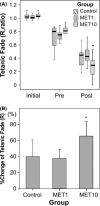Effects of presynaptic muscarinic cholinoreceptor blockade on neuromuscular transmission as assessed by the train-of-four and the tetanic fade response to rocuronium
- PMID: 28394450
- PMCID: PMC5519946
- DOI: 10.1111/1440-1681.12763
Effects of presynaptic muscarinic cholinoreceptor blockade on neuromuscular transmission as assessed by the train-of-four and the tetanic fade response to rocuronium
Abstract
This study investigated the effect of muscarinic M1 and M2 receptor antagonists on the rocuronium-induced train of four (TOF) fade and tetanic fade, respectively. Ex-vivo phrenic nerves and diaphragms were obtained from adult Sprague-Dawley rats and stabilized in Krebs buffer; the nerve-stimulated muscle TOF fade was observed at 20 s intervals. For the TOF study, phrenic nerves and diaphragms were incubated with pirenzepine (an M1 blocker) at concentrations of 0 nmol L-1 (control), 10 nmol L-1 (PZP10), or 100 nmol L-1 (PZP100). Rocuronium was then administered incrementally until the first twitch tension had depressed by >95% during TOF stimulation. The mean TOF ratios were compared when the first twitch tensions were depressed by 40%-50%. For the tetanic fade study, 50 Hz/5 s tetani was applied initially, 30 min after the administration of a loading dose of rocuronium and methoctramine (an M2 receptor blocker, loaded at 0 μmol L-1 [control], 1 μmol L-1 [MET1], or 10 μmol L-1 [MET10]). The EC95 of rocuronium was significantly lower in the PZP10 group than in the control group. In the PZP10 group, the TOF ratios at 50% and first twitch tension depression were significantly lower than those in the control group (P=.02). During tetanic stimulation, the tetanic fade was significantly enhanced in the MET10 group compared to the other groups. This study shows that antagonists of muscarinic M1 and M2 receptors affect the rocuronium-induced neuromuscular block as demonstrated by the reduced EC95 and TOF ratios (M1 antagonist, pirenzepine) or the enhanced 50-Hz tetanic fade (M2 antagonist, methoctramine).
Keywords: acetylcholine release; methoctramine; muscarinic cholinoreceptor; neuromuscular physiology; pirenzepine; rocuronium.
© 2017 The Authors. Clinical and Experimental Pharmacology and Physiology Published by John Wiley & Sons Australia, Ltd.
Figures




References
-
- Tomàs J, Santafé MM, Garcia N, et al. Presynaptic membrane receptors in acetylcholine release modulation in the neuromuscular synapse. J Neurosci Res. 2014;92:543‐554. - PubMed
-
- Pereira MW, Bornia E, Correia‐de‐Sá P, Alves‐Do‐Prado W. Presynaptic muscarinic and adenosine receptors are involved in 2 Hz‐induced train‐of‐four fade caused by antinicotinic neuromuscular relaxants in the rat. Clin Exp Pharmacol Physiol. 2011;38:764‐770. - PubMed
-
- Oliveira L, Timóteo MA, Correia‐de‐Sá P. Modulation by adenosine of both muscarinic M1‐facilitation and M2‐inhibition of [3H]‐acetylcholine release from the rat motor nerve terminals. Eur J Neurosci. 2002;15:1728‐1736. - PubMed
-
- Bornia E, Correia‐de‐Sá P, Alves‐Do‐Prado W. Presynaptic facilitatory adenosine A2A receptors mediate fade induced by neuromuscular relaxants that exhibit anticholinesterase activity. Clin Exp Pharmacol Physiol. 2011;38:164‐169. - PubMed
MeSH terms
Substances
LinkOut - more resources
Full Text Sources
Other Literature Sources

